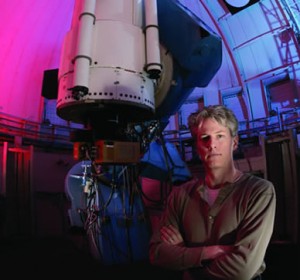5 Questions With…Edward Moran

5 Questions is a new feature in The Wesleyan Connection that will ask faculty members – surprise! – five questions about their work and activities.
This issue, the questions go to Edward Moran, chair and associate professor of astronomy and director of the Van Vleck Observatory. His primary area of study is black holes. This summer he received a major National Science Foundation (NSF) grant for an extensive study on “intermediate mass” black holes.
Q: Everyone thinks they know, but once and for all: what is a black hole?
EM: Technically, black holes are places where matter has been crushed down to a single point. In other words, blacks hole can have the mass of a star but absolutely no size. They therefore have infinite density and, in their immediate vicinity, an extremely intense gravitational field.
Q: How are black holes created?
EM: We only know how stellar-mass black holes are created, which is from the explosions of very large stars. As for the types of black holes I study, the “supermassive” black holes that are found at the centers of galaxies, how they are created and what their initial masses are remain open questions at this time. I’m trying to learn more about the smallest examples of this type of black hole in order to answer these questions.
Q: Isn’t a “small” black hole kind of a contradiction in terms?
EM: Not really, since we’re only talking about their mass. We know that very large stars that are say, 25 to 100 times the mass of the sun, explode when they die and leave behind a stellar-mass black hole maybe 10 times the mass of the sun. We know that at the centers of very large galaxies, like our own Milky Way galaxy, there are very massive black holes 10 million to a billion times the mass of the sun. I am studying smaller galaxies that have smaller black holes at their centers, smaller being somewhere between 1000 and a million times the mass of the sun.
Q: How does one measure the mass of a black hole?
EM: There is only one direct method: observe its gravitational effects on something else that’s nearby. In the best cases we can actually resolve stars in the vicinity of a black hole whose orbital motions are influenced by the gravitational field of the black hole. By using simple physics we can deduce the mass of the thing that the stars are orbiting, even if we can see anything there. This is how the mass of the black hole at the center of the Milky Way was measured.
Q: How did you get interested in black holes?
EM: As an undergrad I took a course on galaxies and cosmology that focused on active galaxies, which are galaxies with black holes at their centers. Around the same time I also worked in the lab of a professor who builds instrumentation for X-ray observatories. Strong X-ray emission is often associated with black holes. So, between the two experiences, I quickly became fascinated by black holes and, well, here I am.

